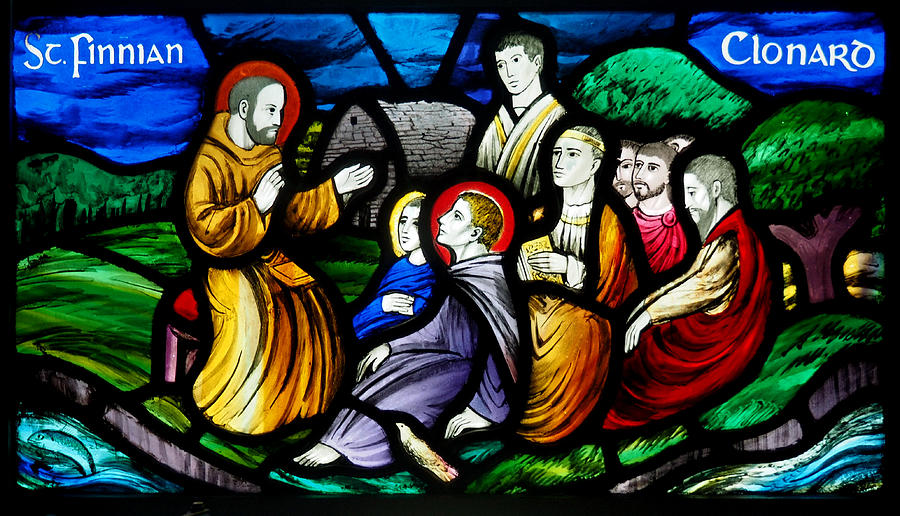
Image source from Fine Art America
Information distilled from material sources such as Catholic Ireland and Omnium Sanctorum Hibernium as well as a prophetic story taken from Orthodox Christians…
St. Finnian (‘Fionáin’ in Irish), was an early monastic saint. He lived from about 470 to 549.
St. Finnian of Clonard is considered the maestro of the Irish saints; notable students include Colmcille of Iona, Ciarán of Clonmacnois and St, Canice (Kenneth). His monastic foundation at Clonard (Cluain Eraird in Irish) was very influential as a centre of theological learning, and from here sprang the twelve Irish disciples; after St. Patrick, they were recognised as the Fathers and Founders of the Irish Church.
Finnian was born at Myshal in Carlow at the foot of Mount Leinster and about 14 minutes drive from Bunclody, in Wexford. Finnian’s father was Finloch of the Rory clann, and his mother was called Telach. While she was pregnant, she had a vivid dream of a bright flying flame that drew very near to her, entering one moment in her mouth, before flying away gloriously, to all the corners of Ireland Ireland, attracting a huge flock of birds that followed. Telach told her husband of the vivid dream, and he predicted that Finnian would become an influential professor and mentor. Finnian grew up to become one of the greatest fathers of the Irish monasticism.
The young Finnian was educated first by Bishop Fortchernn of Trim, a disciple of St. Patrick. From there, the boy proceeded to Wales to grow in virtue and study spirituality under the great saints of Wales; his teachers included great fathers such as St. David, St. Gildas the Wise, and, especially, St. Cadoc. These Welsh saints influenced the Celtic Church in Ireland in that they are said to have given a monastic flavour to the Second Order of the Irish Saints, disciples of Finnian. This form of monasticism resembled some of the traditions of the holy fathers of the Eastern church. Finnian spent thirty years in Wales according to the Salamanca MS. He also studied for awhile in the French monastic centre of St. Martin in Tours in Gaul. Here in France Finnian learned the life of ascetic austerity for spiritual gain.
Then Finnian returned to Ireland, to Aghowle near Shillelagh in County Wicklow, where King Oengus of Leinster gave him a site to build a church. In Irish this place name is Achadh Abhla ; i.e., “Field of the Apple-Tree,”. From there Finnian traversed Ireland, preaching, teaching, and founding churches, as far south as Skellig Michael islands, eight miles off the coast of Co. Kerry. He went north eastwards to Dunmanogue on the river Barrow, in Co. Kildare. He stopped by the town of Kildare, visiting at St Brigid’s monastery. Finnian was esteemed by St. Brigid, who gifted him with a gold ring on his departure.
By the year 520 Finnian arrived at Clonard, (Erard’s Meadow in English). This place was to be his most prominent religious site. He was led to thereby an angel. Clonard is situated on the River Boyne in present day Co. Meath, Ireland’s former royal province. Here Finnian received a large tract of land and built his monastic site, where he entered into a life devoted to study, mortification, and prayer.
Finnian had a strong theological reputation and the Clonard monastery became a centre of Biblical studies, becoming the largest and the most important in Ireland. He became the first abbot and organized life according to the Welsh monastic model. ”The Penitential” compiled by St. Finnian, roots out sin and bad habits while cultivating virtue. Under the influence of Welsh saints and, originally, St. John Cassian in France, Finnian compiled the first known Irish Penitentiary, which later influenced St. Columbanus in his written works. St. Finnian himself slept on the bare earthen floor in his cell without anything for a pillow, to prop his head. One of his disciples recounts that the venerable abbot became emaciated from a prolonged and extreme ascetic life. So much so, his ribs could easily be seen protruding the lining of his tunic. St. Finnian is said to have died in the great plague of 549-550.
The site of the former monastic centre of St. Finnian is located in the grounds of the Church of Ireland at Clonard. He is celebrated on 12th December in the Catholic liturgy.